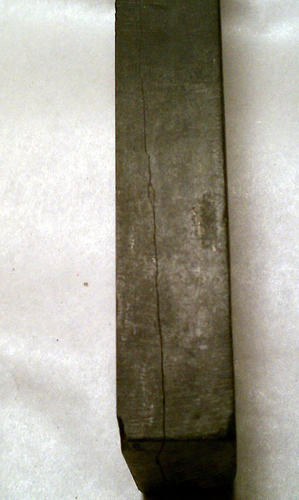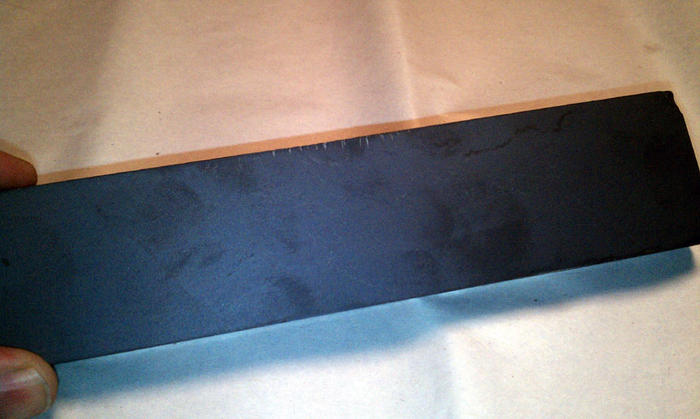Results 1 to 10 of 17
-
12-15-2011, 02:59 AM #1The First Cut is the Deepest!


- Join Date
- Feb 2010
- Location
- Upper Middle Slobovia NY
- Posts
- 2,737
Thanked: 481 Splitting stones (instead of hairs)
Splitting stones (instead of hairs)
Mods, if this belongs in some other spot, please move at your discretion.
I just picked up what I believe to be a Thurry, and while lapping it, noticed that it is starting to split! If it were a clean split, I would help it along, and have 2 slightly thinner stones, but this is working upward at an angle (toward the flat surface) , and if it breaks, it will devastate this stones usefulness.
when I squeeze the end, water (from the lapping) is displaced as the gap closes. when I release it, it springs open again. (only a fraction of an inch, but noticeable)
Do any of you have any "feedback" (bad hone pun) on how to stabilize the split? Glue and clamp? injection of resin with no clamp?
Halp!
(feel free to tell me its not a thurry and I can just toss it and not be worried)

-
12-15-2011, 03:11 AM #2Just a guy with free time.

- Join Date
- Oct 2011
- Location
- Mid state Illinois
- Posts
- 1,448
Thanked: 247
I'd fill it with epoxy, and clamping is up to you. If you get it nice and full, I don't think the clamp would be necessary. And as far as whether or not it's a thuringian, well, try a razor on it. If you get good results, then that's the most important part. Much more important than the name IMHO. Just call it Magpie's hone. It'll be a one of a kind.
-
12-15-2011, 03:35 AM #3

I once glued two stones together to make a combo with Loctite Professional epoxy. Later I wanted to separate the two and soaked them for over a week with no reduction in the bond. Randy suggested the oven @ 600 degrees for an hour. I was able to break the two loose from each other with that but had to use a chisel in the seam to get them apart right out of the oven. Anyway, other epoxies may work as well, but that stuff sticks like..... like glue.
 Be careful how you treat people on your way up, you may meet them again on your way back down.
Be careful how you treat people on your way up, you may meet them again on your way back down.
-
12-15-2011, 03:48 AM #4The First Cut is the Deepest!


- Join Date
- Feb 2010
- Location
- Upper Middle Slobovia NY
- Posts
- 2,737
Thanked: 481
my concern is that if I clamp, the stone might be stressed, and crack at the stress/fulcrum point. But if I DONT clamp, how can I be sure the entire gap is filled so there are no weak spots? Some glues need an abscence of air to cure properly. some are fine in air. Damn it Jim, I'm a wino, not a stone mason!
-
12-15-2011, 04:19 AM #5
-
12-15-2011, 04:45 AM #6

I clamped the stones I glued tightly. Not the same situation as yours but saying that to say, as Mike noted above, no air didn't prevent the epoxies from bonding solid as ....... as a rock.
 Be careful how you treat people on your way up, you may meet them again on your way back down.
Be careful how you treat people on your way up, you may meet them again on your way back down.
-
12-15-2011, 05:17 AM #7

One small tip for getting adhesives into cracks or splits, cut a strip of plastic from an ice cream or margarine container or any thin flexible plastic would do, and punch holes in the strip, use this to work the adhesive in, the holes act as small reservoirs for the adhesive/epoxy, which then get deposited on the sides of the crack more efficiently.
-
The Following User Says Thank You to osdset For This Useful Post:
Magpie (12-15-2011)
-
12-15-2011, 07:45 PM #8Senior Member

- Join Date
- Mar 2009
- Posts
- 1,211
Thanked: 202
Another optin for you could be to use pine pitch. It is waterproof and if you want to repossition the parts just gently heat it up and pull it apart.
-
12-15-2011, 11:42 PM #9

It also a matter of how deep the crack goes and what is causing it. Often times when a rock cracks there is little to stop it. In the real world they use concrete and bolts and wire mesh and all kinds of things. You need something thin enough to get all the way down to the base of the crack if there is any chance to stabilize it.
No matter how many men you kill you can't kill your successor-Emperor Nero
-
12-15-2011, 11:52 PM #10Senior Member


- Join Date
- Apr 2008
- Location
- Saint Paul, Minnesota, United States
- Posts
- 2,944
Thanked: 433
Hobby stores have super glue in various viscosity's, maybe that would work. The thinnest two would probably flow to the base of the crack


 5Likes
5Likes LinkBack URL
LinkBack URL About LinkBacks
About LinkBacks






 Reply With Quote
Reply With Quote



